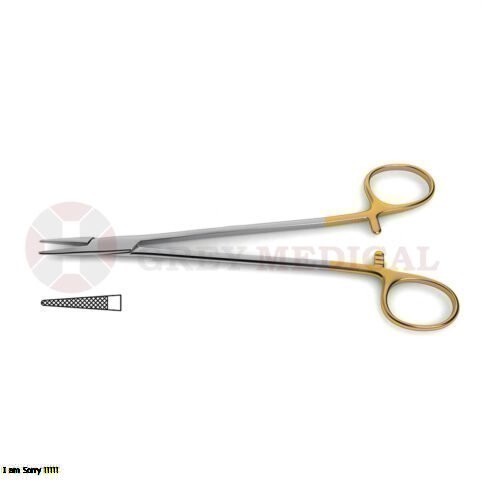Surgical precision can mean the difference between successful patient outcomes and complications. Among the specialized instruments that enable surgeons to perform delicate vascular procedures, the vascular needle driver stands as an indispensable tool that combines engineering excellence with surgical artistry.
Understanding the Vascular Needle Driver
A vascular needle driver is a specialized surgical instrument designed specifically for handling needles during vascular suturing procedures. Unlike standard needle drivers, these instruments feature refined tips, precise gripping surfaces, and ergonomic designs that accommodate the delicate nature of blood vessel repair and anastomosis procedures.
The instrument's primary function involves securely grasping surgical needles while allowing surgeons to manipulate them through tight spaces and around sensitive vascular structures. This specialized tool enables the precise placement of sutures in cardiovascular, peripheral vascular, and microsurgical procedures where accuracy is paramount.
Key Features That Define Excellence
Modern vascular needle drivers incorporate several critical design elements that distinguish them from conventional surgical instruments. The jaw configuration typically features a fine, tapered design that provides optimal needle control without obscuring the surgical field. Many models include tungsten carbide inserts that ensure reliable needle grip while minimizing slippage during critical suturing moments.
The handle design represents another crucial aspect of these instruments. Ergonomic considerations include proper weight distribution, comfortable grip surfaces, and smooth locking mechanisms that reduce hand fatigue during lengthy procedures. Premium models often feature gold-plated handles that resist corrosion and maintain their appearance after repeated sterilization cycles.
Spring tension plays a vital role in instrument performance. Well-engineered vascular needle drivers maintain consistent jaw pressure that securely holds needles without crushing delicate suture materials. This balance requires precise manufacturing tolerances and quality materials throughout the construction process.
Applications in Vascular Surgery
Vascular needle drivers find extensive use across multiple surgical specialties. Cardiovascular surgeons rely on these instruments for coronary artery bypass procedures, valve repairs, and complex cardiac reconstructions. The precision required for these procedures demands instruments that provide exceptional tactile feedback and reliable performance.
Peripheral vascular procedures represent another significant application area. Surgeons performing arterial repairs, bypass grafts, and endovascular procedures require instruments that can navigate confined spaces while maintaining precise needle control. These procedures often involve working with synthetic graft materials and native vessels of varying sizes and conditions.
Microsurgical applications push the limits of what these instruments can achieve. Free tissue transfers, replantation procedures, and complex reconstructive surgeries require vascular needle drivers that can handle extremely fine sutures while providing the precision necessary for successful anastomosis creation.
Material Science and Manufacturing Excellence
The construction of high-quality vascular needle drivers involves sophisticated material selection and precision manufacturing processes. Surgical-grade stainless steel serves as the primary material for most components, providing the durability and corrosion resistance necessary for repeated sterilization cycles.
Advanced manufacturing techniques include precision forging, computer-controlled machining, and specialized heat treatment processes that optimize the instrument's mechanical properties. The jaw surfaces often receive specialized coatings or treatments that enhance grip characteristics while maintaining smooth operation over thousands of use cycles.
Quality control measures throughout the manufacturing process ensure that each instrument meets stringent performance standards. This includes testing for proper jaw alignment, spring tension consistency, and surface finish quality that meets surgical instrument specifications.
Maintenance and Sterilization Considerations
Proper care and maintenance of vascular needle drivers directly impact their longevity and performance. Pre-cleaning protocols involve removing gross contamination and organic matter immediately after use. This prevents protein buildup that can interfere with instrument function and sterilization effectiveness.
Automated cleaning systems provide consistent results while reducing handling risks. Ultrasonic cleaning helps remove microscopic debris from intricate surfaces, while enzymatic solutions break down protein deposits that manual cleaning might miss.
Sterilization protocols must balance effectiveness with material preservation. Steam sterilization remains the gold standard for most surgical instruments, though proper cycle parameters prevent damage to delicate mechanisms and surface treatments.
Choosing the Right Instrument
Selecting appropriate vascular needle drivers requires consideration of multiple factors including intended applications, surgeon preferences, and institutional requirements. Jaw length and configuration affect visibility and access in different anatomical locations. Shorter jaws provide better visibility but may limit leverage, while longer jaws offer increased reach but can obstruct surgical fields.
Handle design preferences vary among surgeons based on hand size, grip strength, and procedural requirements. Some prefer traditional ring handles for maximum control, while others favor pistol-grip designs that reduce hand fatigue during extended procedures.
Lock mechanism style represents another important consideration. Traditional ratchet locks provide secure closure but require deliberate release actions. Quick-release mechanisms offer convenience but may accidentally open under certain conditions.
Innovation and Future Development
The evolution of vascular needle drivers continues as manufacturers develop new materials, coatings, and design concepts. Titanium alloys offer weight reduction benefits while maintaining strength characteristics. Advanced surface treatments provide enhanced grip properties and improved wear resistance.
Digital integration represents an emerging trend in surgical instrument development. Smart instruments that provide usage tracking, maintenance scheduling, and performance monitoring may become standard features in future designs.
GreyMedical® exemplifies this commitment to innovation as a privately owned medical technology company dedicated to innovation and excellence in the craft of surgical instruments. Their focus on continuous improvement and surgeon feedback drives development of instruments that meet evolving surgical requirements.
Conclusion
The vascular needle driver remains an essential component of modern surgical instrument sets, enabling surgeons to perform complex vascular procedures with confidence and precision. As surgical techniques continue advancing and patient expectations rise, these specialized instruments must evolve to meet new challenges while maintaining the reliability and performance characteristics that surgeons depend upon. Success in vascular surgery often depends on having the right tools, and quality vascular needle drivers represent investments in patient outcomes and surgical excellence that benefit both surgeons and the patients they serve.





Comments